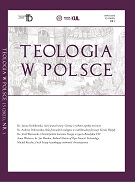Ostatnią fazą przygotowań do przeżywania przez Kościół Wielkiego Jubileuszu Chrześcijaństwa było ogłoszenie przez Jana Pawła II Roku Boga Ojca. Wydarzenie to stało się impulsem do refleksji na temat Pierwszej Osoby Trójcy Świętej. Nie sposób bowiem zrozumieć tego, kim jest Bóg dla człowieka, jeśli nie postawi się w centrum pytania o to, kim jest Ojciec Jezusa Chrystusa.
PATRYLOGICAL ELEMENTS IN THEOLOGY OF JEAN GALOT AND BRUNON FORTE. THE OUTLINE OF PATRYLOGICAL AESTHETICS
Summary
This article presents patrylogical elements of two contemporary, outstanding theologians: Jean Galot and Bruno Forte. According to Galot, God the Father is personally involved in Christ’s salvation work. In Galot’s theology, Father is no longer a distant and abstract being, but He fully participates in his Christs’ s actions. Following this theory, we can speak of God as someone compassionate and emphathecic who accompanies in His Son’s suffering and death and the same expresses his parental love. Bruno Forte went one step further in his Trinitarian thought and presented God the Father as the source and the bosom of nature. Only in such a way God is present in our history. We can experience this misterious presence of biblical God in His silence. According to Forte, only the Word of God and Jesus Christ can lead us straight to God’s Silencethe Father. Only by experiencing God’s Silence, a man can find the source and aim of his existence. This article also presents and develops Forte’s theological esthetics, based on patrylogical elements. Italian theologian develops Christian theology, which presents Christ in Fullness of a complete human being, who share one divine essence. However, this article presents the outline of patrylogical aesthetics. Starting from the methodological side, we can observe extrapolation of Christological tenets, while simultaneously maintaining the reversal of relatioship.
Ostatnia aktualizacja: 09.01.2014, godz. 08:40 - Natalia Haniewska































